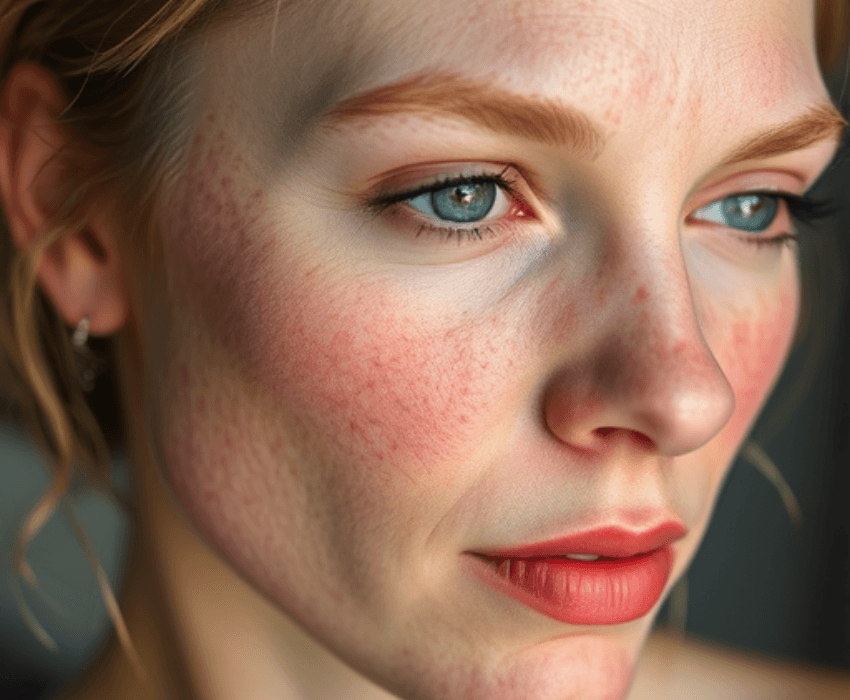The Perfect Skincare Routine For Rosacea

Rosacea is a common but often misunderstood skin condition that causes redness, visible blood vessels, and sometimes bumps or irritation. Managing rosacea can feel like an uphill battle, but the right skincare routine can significantly reduce symptoms and improve your skin’s overall health. Whether you’re newly diagnosed or looking to refine your regimen, this comprehensive guide will walk you through the essentials of a skincare routine tailored to rosacea.
What is Rosacea?
Rosacea is a chronic inflammatory skin condition that typically affects the face. Common signs include persistent redness, visible blood vessels, flushing, and sensitivity to skincare products. While the exact cause is unclear, triggers such as sun exposure, spicy foods, alcohol, and stress often exacerbate the condition.
Understanding rosacea is the first step toward managing it. With proper care, it’s possible to soothe the skin, minimize flare-ups, and regain confidence.
Skincare Routine for Rosacea
A good skincare routine for rosacea focuses on gentle cleansing, hydration, protection, and calming inflammation. Here’s how to build your regimen:
1. Start with a Gentle Cleanser
Cleansing is the foundation of any skincare routine, but for rosacea-prone skin, it’s essential to use a mild, non-stripping formula. Look for cleansers labeled “for sensitive skin” or “rosacea-friendly.”
Key Tips:
- Choose sulfate-free cleansers to avoid irritation.
- Avoid hot water; lukewarm is better for preventing flushing.
- Pat your skin dry with a soft towel instead of rubbing.
Recommended Products:
- CeraVe Hydrating Cleanser ($15 on Amazon)
- La Roche-Posay Toleriane Hydrating Gentle Cleanser ($15 on Amazon)
2. Hydrate with a Calming Moisturizer
Moisturizing is crucial for strengthening your skin barrier, which is often compromised in rosacea. A good moisturizer should lock in hydration and provide soothing benefits without clogging pores.
Ingredients to Look For:
- Hyaluronic Acid: Hydrates without irritation.
- Niacinamide: Calms redness and inflammation.
- Ceramides: Reinforce the skin barrier.
Recommended Products:
- Avene Skin Recovery Cream ($28 on Ulta)
- Eucerin Redness Relief Night Cream ($28 on Amazon)
3. Apply Sun Protection Every Day
Sun exposure is one of the most common triggers for rosacea flare-ups. Daily sunscreen is non-negotiable. Choose a mineral-based sunscreen with zinc oxide or titanium dioxide, as these are less likely to irritate sensitive skin.
Tips for Application:
- Opt for SPF 30 or higher.
- Reapply every two hours if you’re outdoors.
- Avoid chemical sunscreens that may cause stinging.
Recommended Products:
- EltaMD UV Clear Broad-Spectrum SPF 46 ($40 on Amazon)
- Neutrogena Sheer Zinc Oxide Dry-Touch Sunscreen SPF 50 ($12 on Amazon)
4. Treat Redness with Serums and Spot Treatments
Serums formulated to target redness can be a game-changer. These treatments often contain anti-inflammatory ingredients that calm the skin and reduce visible blood vessels over time.
Ingredients to Look For:
- Azelaic Acid: Reduces redness and inflammation.
- Green Tea Extract: Soothes and protects against free radicals.
- Allantoin: Promotes healing and reduces irritation.
Recommended Products:
- The Ordinary Azelaic Acid Suspension 10% ($11 on Amazon)
- Paula’s Choice Redness Relief Repairing Serum ($33 on Amazon)
5. Consider Prescription Options for Severe Rosacea
If over-the-counter products aren’t enough to control your symptoms, consult a dermatologist. Prescription treatments, such as metronidazole gel or ivermectin cream, can help manage moderate to severe rosacea.
Oral Medications:
For persistent cases, oral antibiotics or low-dose isotretinoin may be prescribed to reduce inflammation.
Lifestyle Changes
Your skincare routine is only part of the equation. Managing rosacea also requires avoiding triggers and making small adjustments to your daily habits.
Avoid Common Rosacea Triggers
Certain factors are known to exacerbate rosacea. Keeping a journal to track your triggers can help you better understand what to avoid.
Common Triggers Include:
- Spicy foods and hot beverages.
- Alcohol, particularly red wine.
- Extreme temperatures and UV exposure.
- Stress and intense emotions.
Adjust Your Diet
What you eat can significantly impact your skin’s condition. A diet rich in anti-inflammatory foods may help reduce flare-ups.
Skin-Friendly Foods:
- Omega-3 Fatty Acids: Found in salmon, walnuts, and flaxseeds.
- Probiotics: Found in yogurt, kefir, and fermented foods.
- Green Leafy Vegetables: Rich in antioxidants.
Foods to Avoid:
- Processed sugars.
- Spicy dishes.
- Caffeine in large amounts.
Use Stress-Management Techniques
Stress is a well-known rosacea trigger. Incorporating relaxation techniques into your daily routine can help minimize its effects.
Try:
- Meditation or mindfulness exercises.
- Gentle yoga.
- Regular physical activity, such as walking or swimming.
Myths About Rosacea Skincare
There’s a lot of misinformation about managing rosacea. Let’s debunk a few common myths:
Myth #1: Rosacea is caused by poor hygiene.
This is completely false. Rosacea is an inflammatory condition, not a result of unclean skin.
Myth #2: You should exfoliate to reduce redness.
Harsh exfoliation can worsen rosacea. Stick to gentle products and avoid physical scrubs.
Myth #3: Rosacea can be cured.
While there’s no cure for rosacea, symptoms can be managed effectively with the right routine and lifestyle adjustments.
FAQs About Rosacea Skincare
Q: Can makeup aggravate rosacea?
A: Some makeup products can irritate sensitive skin. Opt for hypoallergenic and fragrance-free options, and always remove makeup gently at the end of the day.
Q: Should I use toners if I have rosacea?
A: Avoid astringent toners with alcohol or witch hazel. If you use a toner, choose one with soothing ingredients like chamomile or aloe vera.
Q: How often should I update my skincare routine?
A: Monitor how your skin reacts and adjust your products seasonally or if your rosacea changes.
Final Thoughts
Managing rosacea requires patience, consistency, and an understanding of what works for your unique skin. By following a tailored skincare routine and incorporating supportive lifestyle changes, you can keep flare-ups at bay and enjoy healthier, calmer skin.
If you’re struggling to manage your symptoms or want personalized advice, consult a dermatologist. Professional guidance can make all the difference in finding long-term relief.